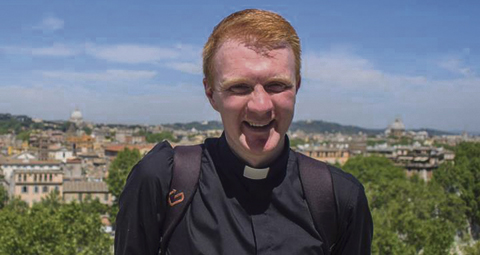BY Daniel Harkins | February 19 | ![]() 0 COMMENTS
0 COMMENTS ![]() print
print

Pray for seminarians from Scotland on their journey
DANIEL HARKINS talks to some of the Scots studying for the priesthood, each on their own spiritual path. Meet Andrew Marshall, Ninian Doohan, Charles Coyle and Jamie McMorrin
Ordained ministry, Pope Francis said recently, is a treasure that God has placed in the hearts of some men, but a treasure—a diamond—that requires polishing with patience. “Please, study well the path of a vocation,” he said.
Scotland currently has around 30 men on that path, studying in seminaries in Rome, Spain and England.
The SCO spoke to some of those seminarians and found that the call to ordained ministry is heard in many different places, in different ways and at different periods of life.
Andrew Marshall, a third year seminarian in St Mary’s College Oscott in Birmingham, has lead a life which highlights the varied journey of today’s seminarians.
Before applying for seminary, he completed a masters degree in modern languages and worked as a teacher, spending many years living abroad, where, he said, he worked and lived among the locals to ‘broaden my horizons and experience new cultures.’
Mr Marshall said he felt the call to priesthood from a very young age but took a long time to answer it, due to ‘feelings of unworthiness and a need to get more life experience.’
“I expressed the call to family and friends when I was a boy and it was even recognised by others, who would often encourage me to put myself forward,” he said.
“When I was 25 I nursed my grandmother through cancer and comforted her on her death bed, as well as easing the pain of my other family members by praying with them. This experience confirmed my calling to me and gave me the final push to step forward and offer my life to God.”
Mr Marshall originally studied in the Scots College in Rome for St Andrews and Edinburgh Archdiocese before doing missionary work in Uganda to discern a missionary vocation.
“I had a wonderful and life-changing experience there but during that time I realised that God needed my services back on my own soil,” he said. “I reapplied for Scottish Diocesan priesthood but this time for the wonderful diocese of Dunkeld.”
Mr Marshall is not alone in his unconventional journey to Dunkeld Diocese. Br Ninian Doohan is currently on the path to ordination for the diocese having already entered religious life with the Canons Regular of Prémontré—also known as the Norbertines—in August 2004. “Over the years I have found that the more I try to explain my vocation the less I am able to make the mystery comprehendible to myself; but Blessed Mother Teresa called it ‘doing something beautiful for God,’” he said.
Br Ninian Doohan was born in Glasgow but grew up in Australia. “During my university years I started asking a great deal of questions to myself, and found that I was more frequently on my knees asking God to make manifest the answers I desired to hear,” he said. “It took a couple of years to be prepared to accept that God was asking me to discern a vocation to the Sacred Priesthood.”
He returned to Scotland believing he would become a seminarian in the country of his birth but ultimately pursued religious life in Manchester and Belgium. A difficult period of prayer and discernment—and a friend in Dundee—eventually led him to the Bishop of Dunkled and assisting at St Mary’s the Immaculate Conception in Lochee.
God willing, he said, he will be incardinated into the diocese after Easter, and in the autumn be ordained to the Sacred Priesthood.
Like Br Doohan, Charles Coyle took some time discerning his vocation. A parishioner of St Columbkille’s in Rutherglen, he pursued a career in horticulture and botany before fulfilling a pact he made with himself that if he turned 30 and was still thinking about being a priest, he would explore the question.
He took part in a seminary applicant’s year, were men interested in ordained ministry can meet with each other and with priests before making any decision, and he entered seminary in 2011.
“I didn’t tell anyone I was going to my first applicants weekend,” he said. “I wanted to finally test my vocation, without the input of anyone else. I had been given opinions on it throughout my life. I think most of my family and friends had thought it was something I had given up on years before. Needless to say that when I told my family there was a good deal of surprise and shock.”
Mr Coyle thinks that if he’d entered seminary when he was younger he would not have completed training, adding that each person’s vocation is different.
“The previous Rector of the [Scots College] said there is no such thing as a late vocation, just a vocation that is at the right time,” he said.
“It’s never too late to explore your calling. I made the pact with myself, because the calling never left me and I knew that if I didn’t try and explore it, I would regret it, sooner or later.”
On life at the Scots College, he said that the 400 year-old seminary is ‘certainly more normal that I thought it would be’ and that while ‘you certainly need to be able to cope with studying’ there are ‘great support mechanisms in place.’
Asked if doubt is a natural part of the process, Mr Coyle said that you ‘need to continually discern, to pray and be open to the possibility that perhaps the Priesthood isn’t for you,’ but that the ‘formation process in the college is very well designed, and enables you to understand your vocation.’
Seminary training can take six to seven years. The process begins when someone considering the priesthood contacts their diocesan vocations director.
An applicant can then attend residential weekends that take place near the end of each year, and following a later conversation with the bishop, a decision will be made on whether the applicant is accepted for candidacy.
If successful, an intense period of training takes place in the Royal Scots College in Spain, before transferring to seminary in either the Scots College in Rome or St Mary’s College in Oscott, Birmingham. The seminary is chosen based on number of factors: a candidate may wish to stay in the UK for instance, or the course at one—the courses at each seminary differ slightly—may be more appropriate for the individual involved.
Jamie McMorrin, a seminarian for St Andrews and Edinburgh Archdiocese, began thinking about the priesthood aged 14 or 15 during a school careers day, despite not attending a Catholic school.
His home parish is St Joseph’ in Burntisland, and it was his childhood priests who inspired him, striking him as ‘deeply happy’ men who ‘were great fun,’ but who also ‘had compelling answers to my teenage questions about the Faith.’
“They weren’t afraid to engage with difficult questions and the idea of Catholicism that emerged from their talks and their preaching was of a God who gave meaning to life and, compellingly, to my life personally,” he said. “More than this, He wasn’t just a nice idea or a clever answer, but a personal God with whom it is possible to have a relationship, and who had a plan for my life.
“These priests encouraged me to pray, and I started trying to pray every day, often walking along the beach near my house.
“Like most people’s experience of discerning a vocation, my experience was not of a Damscus road thunder-clap—my sense of vocation was much more the ‘still, small voice.’”
Deacon McMorrin spoke to his parish priest about vocations while in high school, and was advised to go to university and continue discerning. Whilst studying for a degree, he found himself drawn, ‘sometimes very strongly,’ in other directions—especially towards marriage or to a secular career—but as he got closer to graduation, the idea of priesthood returned regularly during prayer and ‘the quiet moments at Mass.’
“If I was honest, I didn’t think it would work out—more that it was something I had to ‘get out of my system!’” he said. “But every successive step—contacting the Vocations Director, attending the first Seminary Applicants Weekend, being accepted for seminary—gave a deeper and more satisfying sense of peace which is difficult to put into words, but which reassured me that I was on the right path. It wasn’t until I was a few years into seminary that I realised for sure that this was how God was calling me to spend the rest of my life.”
Looking ahead, Deacon McMorrin said he is looking forward to celebrating the sacraments and ‘being in a parish: getting to know the people I’m sent to serve, learning from them, accompanying them through their joys and struggles, in the most important moments of life and death.’
“Especially since I will be ordained as a priest during the year of Mercy, I look forward to absolving sins in the Sacrament of Reconciliation, helping people to experience the tremendous mercy of God,” he added.
Vocations in Scotland are managed at diocesan level and overseen by Priests for Scotland, an agency of the Bishop’s Conference that was started by Fr Andrew McKenzie in 2004. He stressed that people with a variety of skill sets can become priests. “You’re looking for applicants to have the ability to pick up the skills for pastoral ministry and some of those skills can be taught,” he said. “Applicants that, say, would be worried abut public speaking could actually become very good at it. It takes time. It is a formation programme. It’s not looking for ready-made priests. One of the most fundamental things is that an applicant must be open to formation.”
The differing backgrounds of potential seminarians, he said, can be a good thing. “There is a huge variety in age and background and that is okay. That is good; that is nourishing. That should strengthen things to have people with different experiences. They bring different things to ministry and that is important.
“When I was a seminarian 30 something years ago most seminarians were just out of school—seminarians today tend to be a little older and many of them have been to university, though not all of them.
“Many have different experiences from what we had, but the Church that they seek to serve is different too. In society today people are leaving big decisions to a little bit later than they might have done 20 years ago.”
Today, the path to priesthood is different from what it was a generation ago. A seminarian might spend his early twenties teaching abroad, or enter religious life before becoming a priest, or fulfil a pact with themselves after turning 30 and finding they are still hearing the call, or attend a non-denominational school, go on to university and full-time employment before entering training.
“Here in the seminary, there are all sorts of different characters, with all sorts of different backgrounds, life experiences and gifts,” Deacon McMorrin said.
“The same is true, of course, in the disciples the Lord first called: he called them in all sorts of different ways, from all different walks of life. But he chose them all and all of them were needed for the particular mission he had for them.”
— http://priestsforscotland.org.uk/










